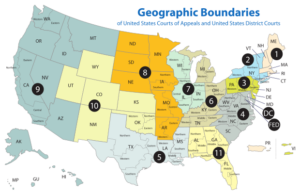The United States federal court system is a hierarchical structure consisting of three levels: the district courts, the courts of appeals, and the Supreme Court. District courts are trial-level courts who have jurisdiction over a wide range of federal cases, including criminal cases, civil cases involving federal law, and cases involving federal agencies. The courts of appeals are intermediate appellate courts, who hear appeals from the district courts and other federal agencies within their geographic jurisdiction. The Supreme Court is the highest court in the United States, and has the final say on all cases involving federal law and the United States Constitution.
 The federal court system was established by the Constitution, which gives Congress the power to create and regulate federal courts. Our first federal courts were created by the Judiciary Act of 1789, which only established district courts and the Supreme Court. The Act also created the Office of the Attorney General and provided for the appointment of federal judges by the President, with the advice and consent of the Senate.
The federal court system was established by the Constitution, which gives Congress the power to create and regulate federal courts. Our first federal courts were created by the Judiciary Act of 1789, which only established district courts and the Supreme Court. The Act also created the Office of the Attorney General and provided for the appointment of federal judges by the President, with the advice and consent of the Senate.
Over time, the federal court system has evolved and expanded to meet our country’s changing needs. The number of federal district courts and judges has increased while new courts of appeals have been established.
The United States Court of Appeals for the Eleventh Circuit (in case citations, 11th Cir.) is a federal court with appellate jurisdiction over the district courts for the following districts:
- Middle District of Alabama
- Northern District of Alabama
- Southern District of Alabama
- Middle District of Florida
- Northern District of Florida
- Southern District of Florida
- Middle District of Georgia
- Northern District of Georgia
- Southern District of Georgia
These districts were originally part of the Fifth Circuit, but were split off to form the Eleventh Circuit on October 1, 1981.
Some notable Eleventh Circuit decisions include:
- United States v. Alvarez-Machain (1992): This case involved the abduction of a Mexican national, Dr. Humberto Alvarez-Machain, from Mexico to the United States to face charges related to the murder of a Drug Enforcement Administration (DEA) agent. The court held that the U.S. government’s conduct did not violate the Fourth Amendment’s prohibition against unreasonable searches and seizures, and that Dr. Alvarez-Machain’s kidnapping did not violate international law.
- Bush v. Gore (2000): This case involved the disputed results of the 2000 U.S. presidential election in Florida. The Eleventh Circuit Court of Appeals upheld the district court’s decision to dismiss the case, which effectively ended the legal challenge to the election results.
- In re Grand Jury Proceedings (2003): This case involved the reporter’s privilege in the context of a grand jury investigation into alleged leaks of classified information. The Eleventh Circuit held that reporters do not have an absolute First Amendment privilege to withhold confidential sources from grand jury proceedings.
- United States v. Davis (2014): This case involved the constitutionality of the federal law that makes it a crime to use or carry a firearm during and in relation to a crime of violence. The Eleventh Circuit held that the law was unconstitutionally vague and violated the Due Process Clause of the Fifth Amendment.
- McDonough v. Smith (2016): This case involved the statute of limitations for a Section 1983 claim for fabrication of evidence in a criminal case. The Eleventh Circuit held that the limitations period does not begin to run until the criminal proceedings against the plaintiff have ended in his favor.